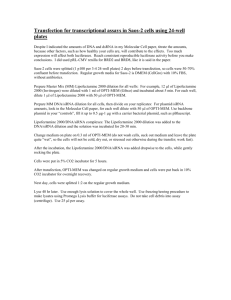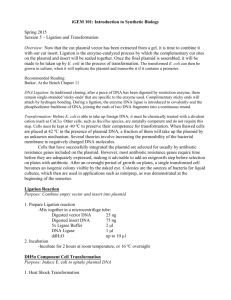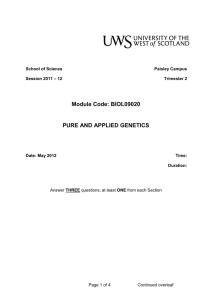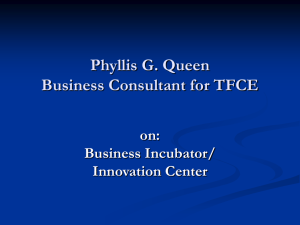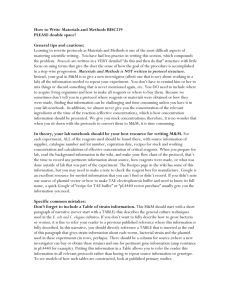Supplementary Information (docx 22K)
advertisement
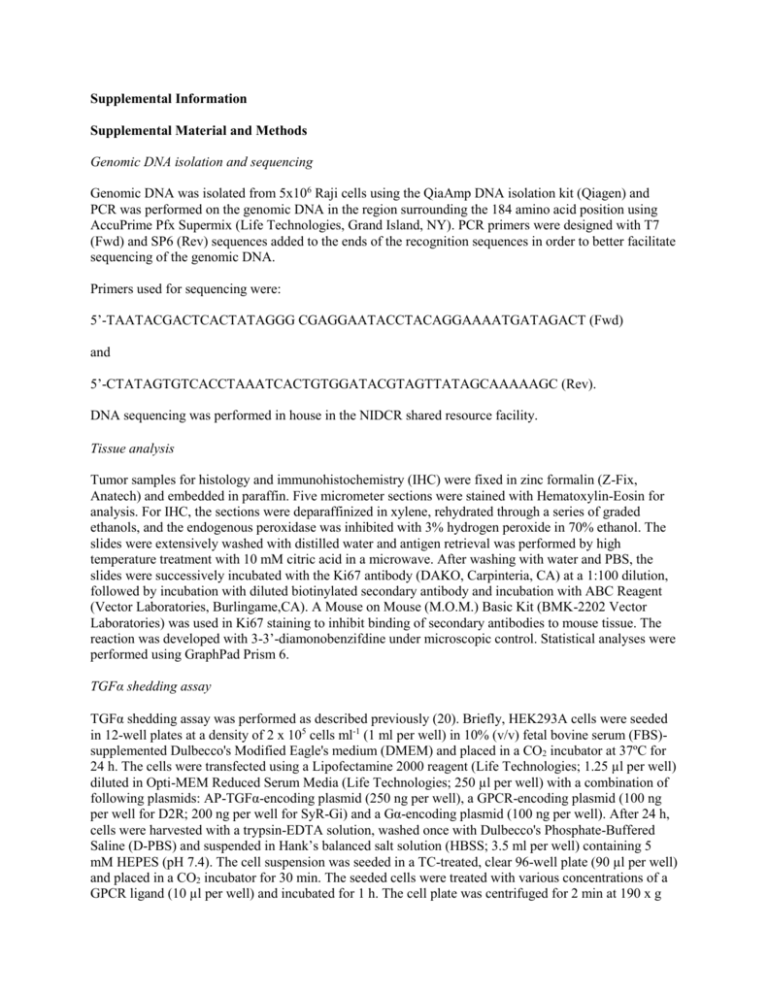
Supplemental Information Supplemental Material and Methods Genomic DNA isolation and sequencing Genomic DNA was isolated from 5x106 Raji cells using the QiaAmp DNA isolation kit (Qiagen) and PCR was performed on the genomic DNA in the region surrounding the 184 amino acid position using AccuPrime Pfx Supermix (Life Technologies, Grand Island, NY). PCR primers were designed with T7 (Fwd) and SP6 (Rev) sequences added to the ends of the recognition sequences in order to better facilitate sequencing of the genomic DNA. Primers used for sequencing were: 5’-TAATACGACTCACTATAGGG CGAGGAATACCTACAGGAAAATGATAGACT (Fwd) and 5’-CTATAGTGTCACCTAAATCACTGTGGATACGTAGTTATAGCAAAAAGC (Rev). DNA sequencing was performed in house in the NIDCR shared resource facility. Tissue analysis Tumor samples for histology and immunohistochemistry (IHC) were fixed in zinc formalin (Z-Fix, Anatech) and embedded in paraffin. Five micrometer sections were stained with Hematoxylin-Eosin for analysis. For IHC, the sections were deparaffinized in xylene, rehydrated through a series of graded ethanols, and the endogenous peroxidase was inhibited with 3% hydrogen peroxide in 70% ethanol. The slides were extensively washed with distilled water and antigen retrieval was performed by high temperature treatment with 10 mM citric acid in a microwave. After washing with water and PBS, the slides were successively incubated with the Ki67 antibody (DAKO, Carpinteria, CA) at a 1:100 dilution, followed by incubation with diluted biotinylated secondary antibody and incubation with ABC Reagent (Vector Laboratories, Burlingame,CA). A Mouse on Mouse (M.O.M.) Basic Kit (BMK-2202 Vector Laboratories) was used in Ki67 staining to inhibit binding of secondary antibodies to mouse tissue. The reaction was developed with 3-3’-diamonobenzifdine under microscopic control. Statistical analyses were performed using GraphPad Prism 6. TGFα shedding assay TGFα shedding assay was performed as described previously (20). Briefly, HEK293A cells were seeded in 12-well plates at a density of 2 x 105 cells ml-1 (1 ml per well) in 10% (v/v) fetal bovine serum (FBS)supplemented Dulbecco's Modified Eagle's medium (DMEM) and placed in a CO2 incubator at 37ºC for 24 h. The cells were transfected using a Lipofectamine 2000 reagent (Life Technologies; 1.25 µl per well) diluted in Opti-MEM Reduced Serum Media (Life Technologies; 250 µl per well) with a combination of following plasmids: AP-TGFα-encoding plasmid (250 ng per well), a GPCR-encoding plasmid (100 ng per well for D2R; 200 ng per well for SyR-Gi) and a Gα-encoding plasmid (100 ng per well). After 24 h, cells were harvested with a trypsin-EDTA solution, washed once with Dulbecco's Phosphate-Buffered Saline (D-PBS) and suspended in Hank’s balanced salt solution (HBSS; 3.5 ml per well) containing 5 mM HEPES (pH 7.4). The cell suspension was seeded in a TC-treated, clear 96-well plate (90 µl per well) and placed in a CO2 incubator for 30 min. The seeded cells were treated with various concentrations of a GPCR ligand (10 µl per well) and incubated for 1 h. The cell plate was centrifuged for 2 min at 190 x g and 80 µl of conditioned media (CM) were transferred into a blank 96-well plate. Alkaline phosphatase (AP) solution (10 mM p-nitrophenylphosphate (p-NPP), 40 mM Tris-HCl (pH 9.5), 40 mM NaCl and 10 mM MgCl2) was added to both the CM plate and the cell plate (80 µl per well). Absorbance at 405 nm (OD405) of the two plates was measured before and after incubation for 1 h at room temperature, using a SpectraMax 340PC384 microplate reader (Molecular Devices). AP-TGFα release was calculated by application of the following formula: AP-TGFαCM (%) = (∆OD405 CM/(∆OD405 CM + ∆OD405 Cell)) x 1.25 x 100 where ∆OD405 denotes increase in OD405 during 1 h incubation and 1.25 was used to normalize AP-TGFα in total (100 µl) CM from measured AP-TGFα in transferred (80 µl) CM. AP-TGFα release = AP-TGFαCM, lig (%) - AP-TGFαCM, veh (%) where AP-TGFαCM, lig and AP-TGFαCM, veh denote ligand-stimulated and vehicle-treated, respectively, conditions. EC50 and Emax values were calculated by fitting data to a four-parameter sigmoid curve using a GraphPad Prism 6 (GraphPad, USA). Spontaneous activity of Gα13 was measured by a previously described method with a slight modification (44). Briefly, HEK293A cells were seeded in 96-well plates at a density of 4 x 105 cells ml-1 (80 µl per well) in Opti-MEM Reduced Serum Media and placed in a CO2 incubator. Then, transfection solution (20 µl per well) was prepared by combining following reagents: Lipofectamine 2000 reagent (0.1 µl per well), the AP-TGFα-encoding plasmids (20 ng per well), Gα13-encoding plasmid (5 to 20 ng per well) and the pCEFL plasmid, which was used to adjust total volume of transfected plasmid. After adding the transfection solution, the cells were incubated in a CO2 incubator for 24 h. AP-TGFα release was measured and calculated as described above except for changes in AP incubation (30 min) and the use of a following formula: AP-TGFα release = AP-TGFαCM, Gα13 (%) - AP-TGFαCM, Mock (%) where AP-TGFαCM, Gα13 and AP-TGFαCM, Mock denote Gα13-expressing and pCEFL-transfected, respectively, conditions.






